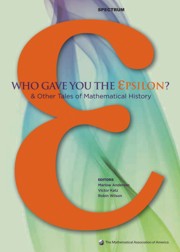Book contents
- Frontmatter
- Introduction
- Contents
- Analysis
- Geometry, Topology and Foundations
- Foreword
- Gauss and the Non-Euclidean Geometry
- History of the Parallel Postulate
- The Rise and Fall of Projective Geometry
- Notes on the History of Geometrical Ideas
- A note on the history of the Cantor set and Cantor function
- Evolution of the Topological Concept of “Connected”
- A Brief, Subjective History of Homology and Homotopy Theory in this Century
- The Origins of Modern Axiomatics: Pasch to Peano
- C. S. Peirce's Philosophy of Infinite Sets
- On the Development of Logics between the two World Wars
- Dedekind's Theorem:√2 × √3 = √6
- Afterword
- Algebra and Number Theory
- Surveys
- Index
- About the Editors
The Origins of Modern Axiomatics: Pasch to Peano
from Geometry, Topology and Foundations
- Frontmatter
- Introduction
- Contents
- Analysis
- Geometry, Topology and Foundations
- Foreword
- Gauss and the Non-Euclidean Geometry
- History of the Parallel Postulate
- The Rise and Fall of Projective Geometry
- Notes on the History of Geometrical Ideas
- A note on the history of the Cantor set and Cantor function
- Evolution of the Topological Concept of “Connected”
- A Brief, Subjective History of Homology and Homotopy Theory in this Century
- The Origins of Modern Axiomatics: Pasch to Peano
- C. S. Peirce's Philosophy of Infinite Sets
- On the Development of Logics between the two World Wars
- Dedekind's Theorem:√2 × √3 = √6
- Afterword
- Algebra and Number Theory
- Surveys
- Index
- About the Editors
Summary
The modern attitude toward the undefined terms of an axiomatic mathematical system is that popularized by Hilbert's remark: “One must be able to say at all times—instead of points, straight lines, and planes—tables, chairs, and beer mugs” ([20], p. 57). This view was not widely accepted before the twentieth century, and even in 1959 the well-known James and James Mathematics Dictionary gave “A self-evident and generally accepted principle” as first meaning of the term “axiom”, although this may only be meant as a reflection of the view universally accepted before the developments in geometry in the nineteenth century. The change in attitude appears to be due to internal pressures within mathematics (what R. L. Wilder ([22], p. 170) has called “hereditary stress”). These include the flowering of projective geometry and, especially, the discovery of the non-Euclidean geometries, i. e., of the possibility of a geometry based on axioms, one of which is the negation of one of Euclid's axioms. The transition from viewing an axiom as “a self-evident and generally accepted principle” to the modern view took place in the second half of the nineteenth century and can be found in the very brief period from 1882 to 1889, from Pasch's Vorlesungen über neuere Geometrie [13] to Peano's I Principii di Geometria, Logicamente Esposti [15].
Already in 1882, Pasch showed a shift in interest from the theorems to the axioms from which the theorems are derived, when he insisted that everything necessary to deduce the theorems must be found among the axioms ([13], p. 5).
- Type
- Chapter
- Information
- Who Gave You the Epsilon?And Other Tales of Mathematical History, pp. 157 - 160Publisher: Mathematical Association of AmericaPrint publication year: 2009



